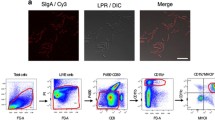Summary
Ribosomal immunotherapy has been successfully used since the 1960s to boost the immune system and provide protection against microbial infections. We have investigated both whether and how these immunostimulants behave as natural immunogens in the mucosa-associated immune system.
According to current understanding of the physiology of the mucosal immune response, intestinal Peyer’s patches and the related solitary nodules are the primary inductive sites involved in the immune protection of all mucosal surfaces. Sensitised lymphocytes generated at these sites reach the general circulation through lymphatic drainage and relocate in mucosal areas by means of specialised ‘high endothelial venules’. We hypothesised that orally administered ribosomal preparations would yield sensitised B cells specific for bacterial antigens from the parent strains. These cells should then be detectable in the peripheral blood after ribosomal intake, and identifiable as plasma cells in mucosae-associated tissues after completing their terminal differentiation. Ultimately, specific IgA should appear in secretions.
To this end, we studied the immune responses generated in children and adults after ‘Ribomunyl’ administration, according to various consecutive protocols. The initial hypothesis was confirmed by the identification of specific B cells in the peripheral blood, plasma cells in the tonsillar tissue and specific IgA in the saliva. An animal model involving the use of twin sheep enabled detection of the specific cells in mesenteric and cervical lymph nodes. Analysis of these data indicates that ribosomal preparations trigger the production of lymphocytes specific for both ribosomes themselves and whole bacterial antigens. This supports the fact that small antigenic motifs are carried as partly synthesised peptides on the ribosomal particles. Therefore, ribosomes boost an array of B cells that are specific for many antigenic determinants of the bacteria from which they are extracted.
We were also able to show that the stimulation provided was specific, since no response to other bacteria could be detected. Finally, analysis of the kinetics of this stimulation confirmed that oral immunisation generates rapid and transient secretory responses, building increased numbers of memory cells that are readily available to respond to further challenges by either more ribosomal preparations or potential pathogens.
Similar content being viewed by others
References
Youmans AS, Youmans GP. Immunogenic activity of a ribosomal fraction obtained from Mycobacterium tuberculosis. J Bacteriol 1965; 89: 1291–8
Faure G, Béné MC. Use of bacterial ribosomal immunostimulators in respiratory tract infections. Clin Immunother 1995; 4: 138–46
Gregory RL. Microbial ribosomal vaccines. Rev Infect Dis 1986; 8: 208–17
Faure GC, Béné MC, Simon C, et al. Increase in specific antibody-forming cells in human tonsils after oral stimulation with D-53, a ribosomal vaccine. Int J Immunopharmacol 1990; 12: 315–20
Zanin C, Perrin P, Béné MC, et al. Antibody-producing cells in peripheral blood and tonsils after oral treatment of children with bacterial ribosomes. Int J Immunopharmacol 1994; 16: 497–505
Zanin C, Béné MC, Martin F, et al. Compartmentalization of specific B-cells in sheep mucosae associated lymphoid organs. Vet Immunol Immunopathol 1994; 42: 349–56
Kolopp-Sarda MN, Béné MC, Allaire JM, et al. Kinetics of specific salivary IgA responses in man after challenge by a ribosomal immunostimulant. Int J Immunopharmacol. In press
Béné MC, Kahl L, Perruchet AM, et al. Bacterial lysates and ribosomes as inducers of specific immune responses: a comparative study. Scand J Immunol 1993; 38: 496–8
Zanin C, Béné MC, Perruchet AM, et al. Bacterial crude extracts or ribosomes are recognized similarly by peripheral and mucosal B-cells. FEMS Immunol Med Microbiol 1994; 10: 11–8
Author information
Authors and Affiliations
Rights and permissions
About this article
Cite this article
Béné, M.C., Faure, G.C. From Peyer’s Patches to Tonsils. Drugs 54 (Suppl 1), 24–28 (1997). https://doi.org/10.2165/00003495-199700541-00007
Published:
Issue Date:
DOI: https://doi.org/10.2165/00003495-199700541-00007




